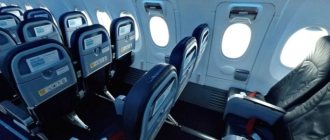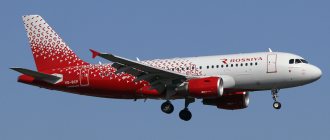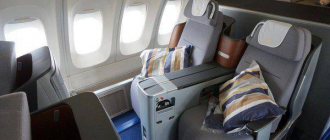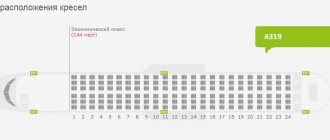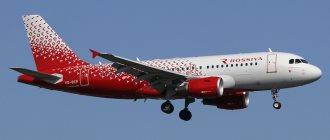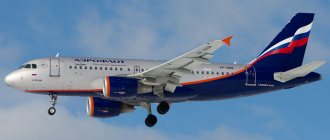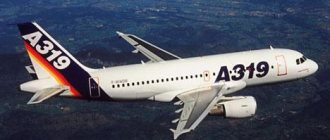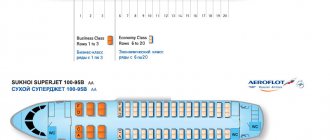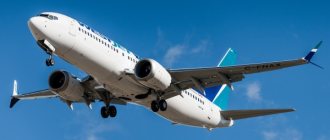Photo, video and cabin diagram of the Boeing 747 airline Rossiya There are nine older Boeing 747s in the Rossiya airline fleet, all of them previously flew with Transaero, although they were originally delivered to Japan Airlines (except for EI-XLM - it flew to Singapore Airlines). The average age of these aircraft is 19 years.
Boeing 747-400 of Russia Airlines
Almost all of them (again, except for EI-XLM) operate resort flights ordered by the tour operator Biblio-Globus. The main destinations are Antalya, Goa, Bangkok, Phuket, Punta Cana, Darnaca, Sharjah, Burgas, etc. The numbers of such flights begin with FV5***. Tickets for these flights are sold on the Biblio-Globus website and in agencies.
EI-XLM flies from Sheremetyevo Airport to Khabarovsk and Vladivostok under the Aeroflot code (SU****) and tickets are sold on the parent airline’s website, in addition, the Aeroflot Bonus program is valid on these flights.
Tigerflight
Tips for choosing a location
Regardless of which modification of the Boeing 747 you are traveling on, it is worth knowing a few general rules for choosing a seat:
- The row layout may vary depending on the airline selected. This applies mainly to the latest modifications of gliders and flights of airlines carrying passengers in first and business class cabins;
- The latest modifications of the Boeing 747 are characterized by reduced noise levels. But it is worth knowing that the least noise is in the nose of the airframe, that is, in places located in front and further from the engines;
- In economy class cabins there are rows with expanded inter-row space, for example, at emergency exits;
- The armrests of the seats do not recline at the edges of the rows, and also often in the first rows of the cabins. Many airlines provide aircraft diagrams with a special icon indicating this point;
- The first rows of salon seats are not equipped with folding tables, but with pull-out armrests.
Taking into account the above factors and knowing the seating diagram will allow you to choose the best place.
Features of choice
Given the huge capacity of the Boeing 747, choosing a seat for a passenger becomes difficult. Before buying a ticket, it is advisable to estimate how comfortable the future seat may be or, on the contrary, inconvenient. Remember that Rossiya Airlines has 7 aircraft of this type, which may differ in different layouts (three layouts are available), so at the registration stage it is advisable to clarify this question and, if necessary, ask the employee to provide a seat by the window, for example, or away from the bathroom . Typically, airport employees at check-in counters are willing to meet passengers halfway and provide seats that passengers request. Of course, you can choose seats within the ticket class. For a more accurate representation of the interior details, it is necessary to consider the arrangement of seats.
Layout
In order not to experience inconvenience during the trip, it is advisable to take the search seriously. In the lower tier of the aircraft, the developers have provided 470 seats, which the airline classifies as “Tourist” class. Affordable airfare prices apply here.
Airplane cabin layout
The standard seat configuration includes several variations, but the basic layout is 3:4:3. In the tail of the plane, the seats are arranged according to the 2:4:2 principle, and in the nose - 2:3:2. The most uncomfortable seats are in the back of the plane, due to the nearby bathroom. Such chairs are traditionally not in demand - after all, fellow travelers and queues constantly passing by are unlikely to add enthusiasm.
Conventional seats are installed in the middle block along the axis of the aircraft. In this sector you will be able to work peacefully and even sleep without being distracted by other travelers. But don’t forget that there is no porthole, so you won’t be able to enjoy the view from the window.
There are 3 blocks of bathrooms installed on the lower deck: in the rear part, between the 43rd and 44th lines and at 20–22 rows. In addition, catering units and dressing rooms are equipped between sectors 31–34 and 54–59. Armchairs next to technical buildings will not be a good choice. In addition, line 31 has a descent from the upper tier of the liner.
A small staircase connects the upper and lower decks of the liner
As for the upper deck, the first three rows are reserved for business class passengers, and seats from lines 5 to 9 are reserved for customers who purchase tickets at the “Advanced Economy” fare. The platform occupies the nose of the aircraft. Here the designers equipped two blocks of restrooms and a staircase to the common salon. This is what the overall layout of the Boeing 747 400 Jet looks like. The interior layout (“Russia”), which we present below, will tell the tourist the best option for choosing a seat.
Modification history
The Boeing 744-400 was developed in 1989. In fact, it is not much different from the previous model. The cockpit was slightly improved, vertical tips were added to the wings, the engines were modified, the comfort inside the passenger compartment was increased and additional fuel tanks were added.
Compared to the Boeing 747-300, this modification turned out to be 25% more economical. In addition, the airliner's flight range has increased significantly. From the moment it entered service until 2005, the Boeing 744 occupied a leading position in terms of passenger capacity. It can carry a maximum of 594 passengers.
If we talk about the modification as a whole, the “four hundredth” modification includes at least 6,000,000 parts, which are produced in 33 countries. The model is still in use, including in the Russian Federation.
Boeing 747-300
One of the features of the new aircraft is a straight staircase to the second floor (previously a spiral was used), an enlarged upper deck designed for economy or business class, and the ability to vary the number of seats. The Boeing 747-300's seating capacity ranges from 400 (operating in three classes) to 600 people when only one class of service is used.
The first Boeing 300 took flight in 1980 and quickly became one of the most frequently used. Until 2005 (the first takeoff of the A-380), this modification was considered the best model of a long-distance airliner, but it also had significant shortcomings.
Models and modifications of the double-deck B747
Over the years of production, a large aviation concern has produced several versions of the Boeing 747: passenger, cargo-passenger and freight aircraft, distinguished by certain technical parameters.
Modifications of the Boeing 747 model:
- 747-100 - the first basic model of double-deck Boeing, developed in the 80s;
- 747SP - an aircraft with a short fuselage and optimized technical and operational parameters;
- 747-200 - an improved model with increased take-off weight and flight range was introduced in 1971;
- 747-300 - an aircraft with an enlarged upper deck and a new straight staircase for transition between floors;
- The 747-400 is a popular model from the Boeing 747 series with improved avionics, improved technical parameters and more economical fuel consumption.
The aircraft manufacturer also designs cargo models of the 747 and military transport versions for the US Air Force.
The giant double-deck passenger aircraft Boeing 747 is currently produced only to order from air carriers. Due to the emergence of new models 777, 787 and A350, the demand for the 747 version of the airliner is gradually fading. Aircraft of this line of cargo modifications do not lose popularity and demand.
Best places
The article provides a typical layout of three classes on an air plane (Germany). The airliner has several first class seats - on the lower floor under the cockpits, 80 seats in business class and almost 300 seats in economy class. The total capacity of the Boeing 747-8 in this configuration is 386 seats.
There were no complaints about the first class - there is a lot of free space for passengers, they have the opportunity to sit comfortably, while each seat is located behind its own screen. Next are the front exits, refreshments and restrooms. The first row seats in business class, although spacious, are limited by a partition behind which there are toilets and a kitchen, which can create some inconvenience. Chairs 9C and 9H are located in close proximity to the aisle and restrooms. Passengers in rows 81 and 88 (second floor, first and last rows) can expect similar inconveniences. Passengers in the tenth row will have to look at the partition in front of them the entire flight, which, naturally, is quite uncomfortable. Business class seats 6 people in a row, with two aisles separating them.
Economy class starts from rows No. 16 and 18. The sixteenth row has only 6 seats. Considering that there are no passengers in front of them, there is enough free space for the occupants of this row and they do not risk finding themselves in the trap created by the reclined seat of the person sitting in front. The same applies to the middle section in the 18th row. The twentieth row is located next to the emergency exit - this explains the absence of portholes. Passengers in the middle section in this row do not have the opportunity to take a horizontal position, since there is a wall of toilets behind them. The 21st-22nd rows repeat the arrangement of rows No. 16-18, except that in the 21st row there are only four seats that are not separated from the rest. There is also enough legroom, the only drawback is that there are emergency exits nearby. The middle section, namely rows 32 and 33, has rear walls, so you won’t be able to relax and lie down. All row 34 seats have a partition in front of them, which can result in limited space. Rows 45-47 are at the back of the plane, so it can be crowded. The 49th row can be called the most unfortunate, since the shortcomings mentioned earlier are fully present in this sector.
Boeing 744. General characteristics
The Boeing 744 is an economical airliner. The designers managed to find a successful combination of powerful engines that do not consume too much fuel during operation. Before the release of the Airbus 380, the Boeing 747 was considered the largest passenger airliner, as it could accommodate 524 people on board. Boeings occupy a significant share of the aircraft fleet of most of the world's leading airlines because they are economical, unpretentious and, with a high capacity, cover more than 14 thousand kilometers without refueling.
Boeing aircraft designers solved an extremely difficult problem - getting rid of strong noise in flight. For this purpose, new engines have been designed and proprietary materials have been developed to suppress noise.
The Boeing 744 has two decks. The upper one is the least spacious and includes business class seats and a small proportion of budget seats. The lower one is a place for traveling only for economy class passengers.
Boeing aircraft
Avia became the legal successor of the bankrupt carrier Transaero, whose fleet of aircraft came under the control of a new owner. The seat arrangement on Boeing aircraft is standard, typical for most aircraft of this model.
Where are the bad places?
It's important to know where the worst places are so you don't accidentally buy a ticket for them. The plane of the Rossiya company has such seats, they spoil all the good impressions of the flight
In row 29, the backrests of the seats do not recline, as there is an emergency exit and a toilet nearby. Same problem in row 19. Seats A, D, E and L also cannot be folded out.
Worst places.
Those sitting on the seat under the letter C in rows 32, 33 and 34 will feel uncomfortable, as passengers will constantly walk past them. There are stairs nearby, along which people regularly walk up and down.
Travelers who bought tickets for rows 43, 54, 79 and 71 will be unhappy with the flight. There are emergency exits nearby, so the seats do not recline.
Important! Seats in lines 20 to 22, 27 to 29, 41 to 46 and 69 to 71 are located near the toilet. Here a queue of passengers forms, additional noise from their conversations and flushing of the tank.
On the second floor you should not buy a ticket for the last line. There is a toilet nearby, where passengers will constantly go, creating inconvenience for those sitting, there is also a staircase along which people go up and down while walking.
Exploitation
The Boeing 747 cannot be called a popular aircraft among global air carriers. The main competitors of this model are the Airbus A300 and Boeing 767. Most often, flights on Boeing 747 airliners are carried out by Asian carriers. Thus, until 2011, the Japanese company Japan Airlines was the largest operator of the 747.
Today, the largest number of Boeing 747-400 units is in the fleet of British British Airways - 48 copies. They operate flights to Beijing, Dubai, Cape Town, Mexico City and other cities and countries.
In Russia, passenger Boeing 747-400s existed as part of the Transaero airline fleet, and were later transferred to the Rossiya air carrier, where they are operated to this day.
As for the 747 line of cargo aircraft, in Russia they are operated by the largest cargo air carrier AirBridgeCargo and Sky Gates Airlines
The latest modifications of the Boeing 747 guarantee safety, speed and comfort of flight. However, it will most likely be possible to experience Boeing's new developments only on flights of foreign air carriers.
Lufthansa cabin layout Lufthansa
Of the foreign airlines that use the double-deck Boeing 747-400, the most popular among Russian-speaking tourists is Lufthansa, which operates flights from Germany (these planes mainly fly from Frankfurt) across Europe and over long distances to Japan, the USA, and Canada.
On board Lufthansa, two options for the layout of the passenger cabin are used.
First scheme:
- Business class - 43 seats;
- Premium Economy - 32 seats;
- Standard economy class - 308 seats.
Upper Deck lufthansa.com
Below Deck lufthansa.com
Second diagram:
- Business class - 67 seats;
- Premium Economy - 32 seats;
- Standard economy class - 272 seats.
Upper Deck lufthansa.com
Below Deck lufthansa.com
All photos of Russia 57 airline
- Sort by:
- Date
- 213
- 1
- 0
Airbus A319 VQ-BCP “Sportolet” airliner of Rossiya Airlines
- 289
- 5
- 0
Boeing 777-300 of Rossiya Airlines takes off at Pulkovo Airport
- 66
- 0
- 0
Boeing 777-300 of Rossiya Airlines takes off at Pulkovo Airport
- 342
- 2
- 0
Passenger cabin in the Airbus A319 VQ-BAS “Zenitolet” of Rossiya Airlines
- 244
- 2
- 0
Economy class seats in the Airbus A319 VQ-BAS “Zenitolet” of Rossiya Airlines
- 213
- 0
- 0
Business class seats in the Airbus A319 VQ-BAS “Zenitolet” of Rossiya Airlines
- 174
- 0
- 0
Airbus A320 VP-BWI of Rossiya Airlines at Pulkovo Airport
- 615
- 9
- 0
Boeing-737-800 of Rossiya airlines at Kaluga airport
- 369
- 3
- 0
Boeing-737-800 “Kaluga” of Rossiya airlines at Kaluga airport
- 1215
- 34
- 0
Passenger cabin of a Boeing 737-800 of Rossiya Airlines
- 1114
- 16
- 0
Passenger seats in a Boeing 737-800 of Rossiya Airlines
- 831
- 14
- 0
Passenger seat in a Boeing 737-800 of Rossiya Airlines
- 480
- 6
- 1
Rossiya Airlines flight attendants
- 774
- 11
- 0
Check-in counters of Rossiya Airlines in Terminal A of Moscow Vnukovo Airport
- 635
- 13
- 0
Boeing-747-400 EI-XLF of Rossiya airlines at Vnukovo airport
- 419
- -2
- 0
Meals on the flight St. Petersburg-Moscow of Rossiya airlines
- 632
- 9
- 1
Boeing-777-300 “Leopard” of Rossiya Airlines at Sochi airport
- 592
- 7
- 0
Boeing 747-400 of Rossiya airlines at Sochi airport
- 441
- 4
- 0
Boeing 777-300 of Rossiya airlines at Sochi airport
- 472
- 4
- 0
Airbus A319 VQ-BAQ of Rossiya Airlines at Pulkovo Airport
- 570
- 4
- 0
Airbus A319 EI-EYM of Rossiya airlines at Pulkovo airport
- 540
- 5
- 0
Airbus A319 of Rossiya Airlines takes off at Pulkovo Airport
- 469
- 0
- 0
Airbus A319 EI-EZC of Rossiya airlines at Pulkovo airport
- 1628
- 33
- 0
Boeing-737-800 VP-BUS of Rossiya Airlines
- 3042
- 45
- 0
An-148 RA-61720 aircraft of Rossiya Airlines
- 713
- 2
- 0
Airbus A319 VQ-BAR of Rossiya Airlines
- 582
- 2
- 0
St. Petersburg – Moscow: Cookies, tea/coffee/water of your choice
- 889
- 6
- 0
Muslim meals on the flight St. Petersburg-Omsk of Rossiya airlines
- 1493
- 9
- 0
Meals in business class of Rossiya Airlines on the Arkhangelsk-St. Petersburg flight
- 1246
- 9
- 0
Airbus A319 of Rossiya airlines at Samara Kurumoch airport
- 415
- 2
- 0
Meal (croissant with chicken) on the Samara-S/Petersburg flight of Rossiya airlines
- 957
- -2
- 0
Business class seats on the Airbus A319 aircraft of Rossiya Airlines
- 604
- 2
- 0
Second meal on the Blagoveshchensk-Moscow flight of Rossiya airlines
- 437
- 3
- 0
Flight catering on the Blagoveshchensk-Moscow flight of Rossiya airlines
- 932
- 2
- 0
Passenger seats on a Boeing 767-300 aircraft of Rossiya Airlines
- 516
- 3
- 0
Flight catering on the Moscow-Blagoveshchensk flight of Rossiya airlines
- 583
- 2
- 0
Airbus A319 aircraft of Rossiya airlines at Pulkovo airport
- 455
- 0
- 0
Meals on the flight Munich-St. Petersburg of Rossiya airlines
- 760
- 1
- 0
The interior of the Airbus A320 aircraft of Rossiya Airlines
The future of the 747
With the development of aviation, many carriers began to need the possibility of long flights without refueling, and therefore the developers again took up the Boeing 747. Passenger capacity in new versions reached up to 800 people. The flight range met the standards of the previously released 747-400 model. But very soon the 747-500 and 747-600 aircraft projects went into the archives. The carriers wanted a new aircraft, not a modernization of the old one. Nevertheless, the developers did not forget about the 747: they modified it, closed it, and modified it again. This continued until 2005. Finally, after the release of the Boeing 787, the corporation announced the return of the 747 model. The new aircraft is codenamed Boeing 747-8, or Advanced.
Carriers, remembering the dubious success of the first versions of the 747, initially ordered 109 aircraft - a third of them in passenger design. The rest were required in the cargo version. A total of 121 vehicles have been sold to date. The capacity of the Boeing 747-8 was not staggering - 581 people using 2 classes of service. By using three classes of service (with the addition of first class), the number of seats is reduced to approximately 400.
Options
This model entered service in 1985. When developing this airliner, the designers took the Boeing 747 300 project as a basis, repeating its unique modification. The new aircraft received recognition due to its more economical fuel consumption and improved noise insulation. In addition, until 2005, the capacity of the Boeing 747 was the largest among all aircraft that existed at that time in the world. The cabin of this giant can accommodate 524 people.
Unfortunately for Boeing, in 2005 Airbus released its new A380 airliner, which today is the leader in the number of seats in the cabin.
The Boeing 747 400 we are considering, whose capacity today ranks second after the Airbus A380, has the following technical characteristics:
- Length: 70.6 meters.
- Wingspan: 64.4 m.
- Cruising speed: 885 km/h.
- Maximum range: 14205 km.
A unique feature of the liner are pieces that produce minimal noise. In total, the Boeing company produced 1,358 such aircraft until 2009, which are successfully operated by various airlines around the world. Despite the fact that the ship has not been produced for 8 years, even today it is one of the most popular among Boeings.
How to choose the best seats, interior layout
The Boeing 747-400, owned by the Rossiya company, can accommodate 522 passengers on two decks (there are aircraft with 477 and 461 seats).
The pilot's cabin is located on the upper deck. It is followed by three rows of comfortable business class. The rows are more than one and a half meters apart, and the seats are arranged in a 2/2 pattern. The seats here are much wider, and LCD monitors are built into the backrests.
Next, behind the screen, the economic salon begins. From the 5th row, the interior layout looks like this: the seat pitch is 86 cm. The screens in the backs are smaller than in the previous comfort class.
5 row. The seats are favorable, there is a screen in front, and there is plenty of legroom.
Behind the 9th row of the upper salon there is a toilet, and next to it there is a staircase leading to the lower deck. These areas may cause minor disturbances during the flight.
The lower deck seats 470 passengers and has 71 rows. The distance between the rows is 78 centimeters, and a monitor is built into each back of the chairs. Most of the interior is made according to the 3/4/3 scheme.
In the bow, rows 10, 11 and 12 have two seats on both sides of the aisle. It is convenient to travel together, these are places of increased comfort. Passengers with children can interfere with a smooth flight, since there are supports for baby strollers installed nearby.
19 row. Next to them there are emergency exits and the backs of seats A, F, E, L can be blocked, and the backs of the remaining seats will be limited in reclining.
Rows 20,21,22. There are toilets on both sides, which is not very pleasant. Airplanes of this class make long flights, and there are many people who want to visit the bathrooms. Immediately behind row 22 there is a wall, which presumably will prevent the seats from unfolding.
29 row. Seats A, L do not have folding seats due to emergency exits. There are toilets nearby.
In row 31, good seats would be A, B, C. There is free space in front of them and you can stretch your legs and sit more comfortably. The tables recline from the armrests - a minus of these places. The proximity of the stairs at place 31C is unfavorable.
Rows 32-33. Their place C is not far from the stairs.
In the rows behind which emergency exits and bathrooms are located (43, 54, 70, 71), the seat backs are limited in folding. You need to find out this fact when purchasing tickets by familiarizing yourself with the layout of the aircraft.
Rows 44 and 45 can be excellent places to travel; good space in front of them is favorable for relaxation. However, the proximity to bathrooms can spoil the flight.
Rows 67-70. Here, the outer seats near the windows are two at a time. Good location for passengers traveling as a couple.
Design features
Features of the structural components of the airliner, its design and manufacture:
- How many engines does a Boeing 777 have to lift such a huge machine into the air? Like the vast majority of modern jet aircraft - two, but the largest and most powerful in the history of aircraft construction. The diameter of one of the engines installed on the airliner, GE90-115B, is only 0.3 m smaller than the width of the Boeing 737 cabin.
- The huge dimensions of the aircraft should determine how much the Boeing weighs. In fact, its weight is much lower than it might seem, thanks to the use of composite materials. Aerodynamic fairings, the main beams of the floor of the cabin for passengers, elevators - 9% of all parts - are made from them.
- The aircraft's wings are wider and thicker than those of other airliners, and their design is optimized for cruising speed. This contributed to an increase in flight range and altitude.
- The landing gear consists of six wheels with powerful struts, which distinguishes the Boeing 777 from other aircraft. One tire carries a 27-ton load.
- The airliner has three hydraulic systems that back up each other, while during landing it is necessary to use one.
- To provide emergency power, there is a retractable wind turbine under the fuselage.
- The spacious cockpit has a simple design and is equipped with an electronic fly-by-wire control system, but it was decided to leave the traditional steering wheels. Avionics are fully programmable. Fiber optic cables for avionics were used for the first time on a passenger aircraft.
Interesting! For the first time in history, when designing the Boeing 777, drawings on paper were not used, only computer graphics in three-dimensional images. Thanks to the preliminary computer assembly of the liner, it was possible to get rid of production errors.
First flights
Despite financial difficulties, the first wide-body airliner took off in 1970. Since the airliner was a passenger one, the upper deck became a service deck, and all passengers were accommodated according to the principle usual for other aircraft. The capacity of the first Boeing 747 models was only 200 people, but if you compare it with the 737 model, released the same year and taking 100 people on board, the difference is twofold.
Active interest in the new airliner significantly undermined the position of the Concordes - supersonic European aircraft: many carriers revised their orders and shares of the Boeing 747 began to grow rapidly. Based on the first aircraft, production of several modifications began. The first of them was developed for a Japanese carrier, and the order was for short-range aircraft. The response to the Japanese order was the modification 747-100SR. This version received an improved fuselage and smaller tanks, thereby significantly increasing the aircraft's capacity. The Boeing 747-100SR was able to carry 500 and then 550 people. Later, the 747-300 development will receive the same modification - an aircraft flying short distances.
History of the development of the Boeing 747 passenger aircraft
In the mid-1960s, due to an increase in passenger traffic and the development of jet aviation, a demand arose for long-range aircraft with increased passenger capacity. At that time, the world was flying mainly first-generation jet aircraft, such as the Boeing 707, Tu-104 and others.
However, such aircraft could no longer cope with the load, and the first generation aircraft also had many design and other problems. As a result, Boeing decided to begin developing a new modification of airliners. In 1966, a car was presented to the public, completely different from its predecessors, with a hump on the roof. Initially, they wanted to make the plane double-decker, but due to the lack of experience in producing such aircraft, the look for which the 747 is famous was adopted.
Boeing 747 "Tigrolet" aircraft
In connection with the entry into the supersonic passenger aviation market, the corporation was quite skeptical about the aircraft. The removal of the cockpit to the upper deck was caused by the considerations that if suddenly the aircraft was not sold, it would quickly be converted into a cargo model, and for this, the cockpit should not interfere with the loading of cargo through the bow ramp, which will be in the truck.
It was believed that the maximum required was 400 aircraft of this type. However, at the moment more than one and a half thousand aircraft have been sold. If it were not for the direct competitor - the A380, the number of aircraft sold would have been even greater. Pratt & Whitney created a turbofan engine specifically for this aircraft - the JT9D. The wing mechanization, “advanced” for those times, was developed, which made it possible to use a heavy side from standard runways (runways).
State-owned US Air Force aircraft factories were widely used in the production of the Boeing 747. The law prohibits the involvement of state-owned factories to fulfill commercial orders of other companies. Let us leave this fact without comment.
Interior layout: best and worst places
Let's look at the layout of the Boeing 744 cabin in the airliners of Russia Airlines. The layout of seats on the plane is two-class. This aircraft model has two decks: lower and upper.
The plan shows which seats on board are considered the most and least comfortable
Upper deck: seats
The layout of the upper deck of an airliner looks something like this: from the first to the fourth rows. This is an excellent modern business class that has all the necessary amenities: wide and soft seats, 15.4-inch monitors. Passengers are especially pleased with the space between the rows - this figure is more than one and a half meters.
In economy class rows, special attention should be paid to rows 5-9 of the upper deck. Row 5 is also the first row of economy class
It is located directly behind the partition separating the classrooms. There is also ample legroom here - the distance between the rows is 86 centimeters. These chairs are considered seats of increased comfort.
As for the last row of the upper deck (row 9), it can be considered the most inconvenient - it is located directly next to the toilet and the stairs leading to the lower deck. Such an arrangement, due to a consistently large crowd of people, can cause serious discomfort for passengers. Therefore, the seats in the last row can rightfully be considered the most uncomfortable on the entire plane.
Lower deck: seats
Speaking about the location of seats on the lower deck of the airliner, it should immediately be noted that all the seats located in this part of the plane belong to economy class. The distance between the seats is 78 centimeters, and the monitors on the backs of the seats in front have a diagonal of 8.9 inches.
Flying in economy class on this transcontinental airliner is quite comfortable
Seats with the letters A, B, H, K in the 21st, 22nd and 23rd rows have a layout of two seats in a row. They can be called places of increased comfort. Two chairs next to each other are always more comfortable than three located in the same way. When purchasing air tickets, you should keep in mind that the Boeing 744 cabin layout has this feature.
It is worth paying attention to places A, B, C in row No. 40. There is quite a significant space for placing legs.
Speaking of the worst places on the lower deck, it should be noted the location of the seats in row No. 29. They are too close to the emergency exits. At the same time, in seats A, L, D, E the backrest does not recline at all, and in the rest it has serious limitations in this regard.
Seats D in rows 30 to 32 will not be too quiet for a flight. They are located in close proximity to the toilet, and the number of people wishing to visit the bathroom during a long flight throughout the entire time spent in the air remains at a consistently high level. So there will be plenty of “pleasure” of sitting in this row - this is an unpleasant smell, and the loud sound of the drain, and crowds of people waiting for their turn.
Seats in rows 40 to 42 are located next to the stairs to the upper deck, which can also cause a number of inconveniences.
As for the seats in rows 53 and 64, they could be considered quite comfortable if not for the special proximity to the onboard buffets and toilets.
By carefully studying the plane plan of the airline you plan to fly with, you can clearly see where it will be comfortable to sit and where it will not be so comfortable. However, even if you manage to purchase tickets for seats that are considered the most comfortable, you should never forget about the human factor - unfortunately, no one has canceled it. And an unpleasant neighborhood may well ruin a flight, regardless of the seat occupied.
Travel tips
When purchasing a ticket on the airline’s official website, you can find the necessary form to familiarize yourself with the layout of this board. If you wish, you can call the airline manager, who will not refuse to help you choose a suitable seat. It is advisable to notify the employee of personal preferences and desire to sit, for example, near the window.
You should not buy a ticket for a seat that is located near the service premises. Usually, queues form near such premises and people are constantly moving, which creates unnecessary noise.
It is necessary to reserve seats where you can recline your back and stretch your legs - this is very important during a long flight.
A very bad option is to book a seat next to the partition. And if the flight is planned for the morning or in good weather, then it is advisable to reserve a seat near the window in order to enjoy the scenery outside the window during the flight.
Considering how large the capacity of the Boeing 747 aircraft is, the layout of the seats on the airliner needs to be studied in more detail. There you can determine better zones and places, the location of technical blocks, restrooms. Try to choose a place away from these premises. Remember that this may determine your overall flight experience. In addition, good conditions are especially important for people who are afraid to fly. After all, comfort reduces passenger stress and nervous tension. After a flight, a person can get off the plane full of energy, or he can be severely exhausted by the constant noise.
Indeed, the passenger capacity of the Boeing 747 allows this aircraft to be used on the busiest flights. The carrier does its best to ensure that its boards are filled with people as much as possible, so you should not count on the fact that the plane will be half empty and you will be able to take any seat. This happens extremely rarely with huge liners of this level.
Best seats on the lower deck
The lower deck is a regular aircraft cabin that can accommodate quite a lot of people.
The best places are here:
- Rows 21-23, but only places like A,B,H,K. The fact is that this is the bow of the plane, the seats here are arranged in pairs, that is, you will only have one neighbor instead of two. These seats are also convenient for those traveling with children, as there are mounts for bassinets. On the other hand, for some this may seem like a disadvantage, because you will be surrounded by small children, so the flight may be noisy and fussy.
- Row 40 seats A, B, C have more legroom, only a toilet and an emergency exit are located not far from them, this can cause inconvenience. Near 40 C there is a staircase to the top, some may find this inconvenient, although during the flight people rarely use it.
- 53 row. Similar to row 40, only there are no stairs or toilets. But there is plenty of legroom. The seats here are divided into threes, with an emergency exit located nearby.
- 64 row. Another similar series. There is an emergency exit nearby and increased legroom. But here there is a buffet between the left and right seats.
Other modifications
Despite growing orders for passenger versions, Boeing has not abandoned its original plans to produce cargo aircraft. This is how the following modifications appeared: F - cargo version, M - combi, which has the ability to take fewer passengers but more luggage, B - improved chassis (for the first versions) and tanks (later). In addition, on the basis of the 747-200, two classic “Air Force No. 1” were assembled to transport the US President.
The 200 modification served as a prototype for the next generation - the 300s, the only difference of which was to have three engines instead of the standard four. But this decision was not continued - the Boeing 747-300 became a completely new airliner.
Interesting Facts
Finally, we list some interesting and little-known information about such airliners. To produce the first batch of Boeings of this class, the developers borrowed 2 billion US dollars, which by the standards of that time was considered an astronomical amount. In addition, specifically for the production of such giants, the company built a plant in the city of Everett, Washington, the dimensions of which allowed the production of such large models.
An entire plant was specially erected for the construction of a batch of Boeing 747s, which remains the largest building in the world.
This building today is the largest building in the world. Let us note that the deadlines for the implementation of the initial project did not tolerate delays, so the first airliner was assembled in the open air - there was still no roof over the workshop. However, this nuance did not prevent the workers from fulfilling the order. At the time the production of such models ceased, the company produced 1,494 units of boards of this series.
The aircraft's wing sweep is 37.5º - this figure exceeds similar parameters for airliners from other manufacturing companies. And placing depleted uranium in opposition to the power plant solved the problem with harmful wing vibrations at high altitudes.
Such aircraft are widely used both in the field of passenger transportation and as auxiliary equipment for civil aviation. The Evergreen 747 Supertanker is the largest firefighting aircraft in the world. On board such a giant can accommodate up to 75,710 liters of chemical reagents for extinguishing fires. In addition, NASA prefers such models for transporting space shuttle elements.
Boeing 747 airliner - the largest firefighting aircraft in the world
As you can see, the 747 series aircraft is deservedly considered a legendary development and a breakthrough in aviation design. The unusual shape of the side only added to the originality of the liner - thanks to the “hump”, this aircraft cannot be confused with other models. We think that readers will find the information presented above useful, and you can learn about the most reliable aircraft in the world here.
The Boeing 747 is the first wide-body airliner, which remained the largest passenger aircraft for 35 years. The first flight of such a model was carried out in 1970. Improved aerodynamic performance contributes to the development of a cruising speed of 910-950 km/h. The flight deck of the Boeing 747 400 aircraft. The cabin of the aircraft for three class of service involves the transportation of up to 416 people Boeing 747 - the longest aircraft in the world For the construction of a batch of Boeing 747, an entire plant was specially erected, which remains the largest building in the world Liner Boeing 747 - the largest firefighting aircraft in the world Maximum capacity of the model - 660 passengers Take-off speed of the Boeing 747 is 270 km/h
Flight characteristics of the Boeing 747
| Characteristic | 747-100 (original version) | 747-400ER | 747-8 |
| Maximum take-off weight | 340.2 t | 412.8 t | 442.2 t |
| Maximum speed | M=0.84 | M=0.855 | M=0.855 |
| Cruising speed | 955 km/h | 988 km/h | 988 km/h |
| Range with maximum load | 9800 km | 14,205 km | 14,815 km |
| Fuel reserve | 183 380 l | 241 140 l | 242 470 l |
| Cabin width | 6.1 m | ||
